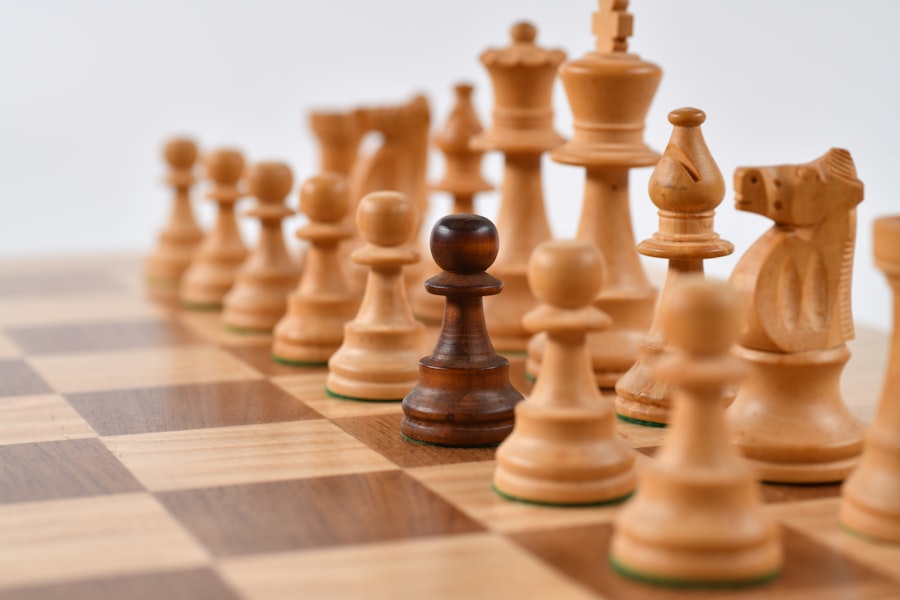Download links
How to install Mastering Chess: Strategies for Success APK?
1. Tap the downloaded Mastering Chess: Strategies for Success APK file.
2. Touch install.
3. Follow the steps on the screen.
Description
Chess is a strategic board game that has captivated minds for centuries, originating in India around the 6th century AD before spreading to Persia and then to Europe. The game is played on an 8×8 grid, known as a chessboard, where two players command an army of 16 pieces each, consisting of one king, one queen, two rooks, two knights, two bishops, and eight pawns. Each piece has its own unique movement rules, which contribute to the game’s complexity and depth.
The objective is to checkmate the opponent’s king, meaning the king is in a position to be captured and cannot escape. Understanding the basic rules and movements of each piece is crucial for any aspiring chess player. The king moves one square in any direction, while the queen can move any number of squares along a rank, file, or diagonal.
Rooks move in straight lines along ranks and files, bishops traverse diagonals, and knights have a unique L-shaped movement that allows them to jump over other pieces. Pawns move forward one square but capture diagonally; they also have the option to move two squares forward on their first move. Familiarity with these movements lays the groundwork for more advanced strategies and tactics.
Key Takeaways
- Chess is a game played on an 8×8 board with 16 pieces on each side, and the goal is to checkmate the opponent’s king.
- A strong opening repertoire involves learning and understanding various opening moves and their strategic implications.
- Tactical play involves creating threats and opportunities, while positional play focuses on long-term advantages and maneuvering.
- Improving endgame techniques involves understanding key principles and practicing common endgame scenarios.
- Studying grandmaster games can provide valuable insights into high-level strategic and tactical decision-making.
- Mental preparation and focus are crucial for success in chess, and techniques such as visualization and meditation can be beneficial.
Developing a Strong Opening Repertoire
A well-structured opening repertoire is essential for any chess player aiming to improve their game. The opening phase of chess sets the stage for the middle game and can significantly influence the outcome of the match. Players must choose openings that align with their playing style—whether aggressive, defensive, or somewhere in between.
For instance, the King’s Gambit is an aggressive opening that sacrifices a pawn for rapid development and control of the center, while the Sicilian Defense offers Black counterplay against White’s 1.e4. To develop a strong opening repertoire, players should study various openings and understand their underlying principles rather than memorizing moves blindly. This includes grasping concepts such as controlling the center, developing pieces efficiently, and ensuring king safety through castling.
A player might choose to focus on a few key openings for both White and Black, allowing them to become familiar with typical plans and tactics associated with those lines. For example, if a player opts for the Ruy Lopez as White, they should delve into its main variations and understand the strategic ideas behind them.
Mastering Tactical and Positional Play

Tactical awareness is a cornerstone of chess mastery. Tactics involve short-term calculations that can lead to immediate gains, such as winning material or delivering checkmate. Common tactical motifs include forks, pins, skewers, discovered attacks, and double attacks.
For instance, a knight fork can simultaneously attack two pieces, forcing the opponent to lose material. Regular practice with tactical puzzles can sharpen a player’s ability to recognize these patterns during actual games. Positional play, on the other hand, focuses on long-term advantages rather than immediate gains.
It involves understanding pawn structures, piece activity, and control of key squares. A player might sacrifice material for better piece placement or to create weaknesses in the opponent’s position. For example, in a closed position where pawns block many pieces, a player may aim to improve their minor pieces’ activity while restricting their opponent’s options.
Balancing tactical opportunities with positional considerations is vital for success at higher levels of play.
Improving Endgame Techniques
| Technique | Description | Benefits |
|---|---|---|
| King and Pawn Endgames | Focuses on using the king to support the advancement of pawns in the endgame | Improves understanding of pawn promotion and endgame strategy |
| Rook Endgames | Teaches how to use rooks effectively in the endgame, including the concept of the “Lucena position” | Enhances ability to convert advantages into wins in rook endgames |
| Bishop and Knight Endgames | Explores the unique challenges and strategies of endgames with bishops and knights | Develops proficiency in handling complex endgames with minor pieces |
| Opposite-Color Bishop Endgames | Examines the dynamics of endgames with bishops of opposite colors | Enhances understanding of drawing chances and winning possibilities in such endgames |
The endgame is often where many games are decided, yet it is frequently overlooked by players who focus primarily on openings and tactics. Understanding endgame principles can turn a drawn position into a win or salvage a lost game into a draw.
Studying fundamental endgame positions is essential for improvement. For instance, knowing how to convert a king and pawn versus king endgame into a win requires understanding how to use the king actively to support pawn advancement while keeping the opponent’s king at bay. Additionally, players should familiarize themselves with common theoretical endgames such as rook versus pawn or bishop versus knight scenarios.
Studying Grandmaster Games
One of the most effective ways to deepen one’s understanding of chess is by studying games played by grandmasters. These players possess an exceptional grasp of strategy, tactics, and psychological elements that can be invaluable for aspiring players. Analyzing grandmaster games allows players to see how top-level competitors handle various positions and openings while providing insight into their thought processes.
When studying these games, it is beneficial to focus on specific themes or concepts rather than merely replaying moves. For example, one might analyze how a grandmaster transitions from the opening into the middle game or how they handle critical moments when faced with tactical complications. Additionally, many grandmasters annotate their games with explanations of their thought processes during critical moments; these annotations can provide invaluable lessons on decision-making and strategic planning.
Mental Preparation and Focus for Chess Success

Chess is as much a mental battle as it is a physical one; thus, mental preparation plays a crucial role in achieving success on the board. Players must cultivate focus and concentration to navigate complex positions effectively. Techniques such as visualization exercises can enhance a player’s ability to foresee potential moves and outcomes without relying solely on physical boards or pieces.
Moreover, managing emotions during play is essential for maintaining composure under pressure. Players often face challenging situations where they must make critical decisions quickly; developing resilience against frustration or anxiety can significantly impact performance. Techniques such as mindfulness meditation or breathing exercises can help players maintain calmness during tense moments in a game.
In addition to emotional regulation, setting realistic goals can foster motivation and improvement over time. Whether aiming to reach a specific rating or mastering a particular opening line, having clear objectives helps players stay focused on their development journey. By combining mental preparation with practical skills learned through study and practice, players can enhance their overall performance and enjoyment of chess.
If you are a fan of strategy games like chess, you may also enjoy reading about the popular mobile game Plants vs. Zombies 2. This game requires players to think strategically and plan their moves carefully to defeat the zombies. You can learn more about this game by checking out the article here.
FAQs
What is chess?
Chess is a two-player strategy board game that is played on an 8×8 grid. It is one of the most popular and enduring games in the world, with a rich history dating back over a thousand years.
How is chess played?
Chess is played on a square board divided into 64 squares, with each player starting with 16 pieces: one king, one queen, two rooks, two knights, two bishops, and eight pawns. The objective of the game is to checkmate the opponent’s king, which means putting the king into a position where it cannot escape capture.
What are the basic rules of chess?
Each type of chess piece moves in a specific way, and players take turns moving their pieces across the board. The game ends when one player’s king is in checkmate, or when a stalemate is reached.
What are the benefits of playing chess?
Chess has been shown to have numerous cognitive benefits, including improving memory, concentration, problem-solving skills, and strategic thinking. It is also a great way to improve patience and decision-making abilities.
What is the history of chess?
Chess originated in India around the 6th century and spread to Persia, where it became known as “shatranj.” It then made its way to Europe and evolved into the game we know today. Chess has a rich and storied history, with many famous players and iconic matches throughout the centuries.
Are there different variations of chess?
Yes, there are many variations of chess, including speed chess (blitz and bullet), chess960 (also known as Fischer Random Chess), and team chess (such as bughouse). Each variation has its own unique rules and strategies.





